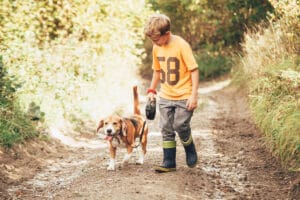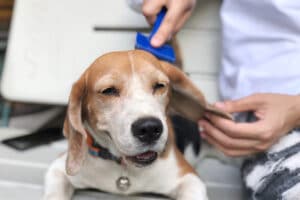Beagles have a personality that can keep you on your toes. They are little comedians and can make you laugh, but can often be naughty and somewhat stubborn if not given set boundaries as puppies. Beagles will spend plenty of time exploring their environment and trying to find new things to get into. If left unsupervised, it’s always recommended that you place your Beagle in a crate or you might come home to a mess on your hands.
Beagles are small dogs with compact and sturdy bodies. As such, they make great lap dogs for adults and energetic playmates for children. They love being a part of the family and the centre of attention and will give you hours of enjoyment during a play session.
In addition, even though Beagles are small, they are not “yappy” dogs. They will, however, bay as all good hounds do. This may not be to the delight of your neighbours, or your own family, so before adding a Beagle to your family, make sure everyone is on board with their vocalizations.
Aggression Levels
Beagles are extremely friendly and outgoing little dogs. While they will bark or bay at a delivery man coming up your driveway, they would much rather make friends with them than guard your home. If you are looking for a dog that protects your property, a Beagle is not the best choice.
Some Beagles do have food aggression issues. They love to eat and are the type of dog that can eat themselves sick if given the chance. Obviously, you want to ensure your Beagle’s food and treats are kept out of their reach at all times, but during feeding times it may be good to teach your children to leave the Beagle alone while he is eating.
Preventing Boredom
Beagles are extremely intelligent small dogs that love figuring out new problems. Toys that make them work for a treat can be very appealing to this breed. Additionally, providing “snuffle mats” or other toys that require the Beagle to use its nose is a much-appreciated boredom buster.
If you are leaving your Beagle unattended for long periods of time while at work or school, it’s important that your Beagle is either contained in his own safe and secure crate or provided with a variety of activities that he can enjoy on his own. Leaving plenty of toys and snack items hidden around your home can help occupy your Beagle’s alone time and prevent boredom.
Beagles that get bored can revert to some very unappealing behaviours such as obsessive barking or howling, digging, chewing, getting into the trash can, or ripping apart pillows and soft furniture. It’s extremely important that you thoroughly Beagle-proof your home, as a beagle can and will learn how to get into the pantry, may jump onto counters, and can get into food items that may be dangerous.
Being Around Children
Beagles are exceptionally well adapted to being in homes around children. They are energetic and rowdy small dogs that can hold their own with a bit of roughhousing and play-wrestling with older children. They can also be very calm and loving with smaller children and babies if they are properly socialized right from the start.
The biggest issue with Beagles is they can be “mouthy.” For example, if your child is holding a toy that the Beagle wants, the Beagle won’t hesitate to grab the toy for himself. This can lead to accidentally pinched fingers or small bruises from the Beagle’s teeth. While this is not an act of aggression, it’s simply a Beagle’s way of saying “I want this and I’m taking it.” This is a trait that can be trained out of a Beagle, so be sure to address this if you notice it in your small hound.
Being Around Other Pets
Beagles are very much a pack oriented dogs. Since they are a hound breed, it’s not uncommon for Beagles to be kept in hunting groups or packs. This is a trait that has been ingrained into their nature and, as such, a Beagle of any age will be especially happy to have companionship with other animals; be it another dog or a cat.
Beagles were originally bred for hunting fox, rabbits and other small mammals – so they may not be the best dogs around pet rabbits, guinea pigs, or rats. While proper socialization with the small pet can be done, you should never leave your Beagle unsupervised with the small pet as their breeding and hound heritage may decide to show up.









